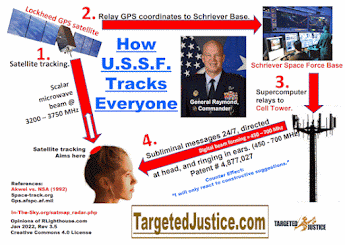Patent No. 6547746 Method and apparatus for determining response thresholds
Patent No. 6547746
Method and apparatus for determining response thresholds (Marino, Apr 15, 2003)
Abstract
A method and apparatus for evaluating the response of a biological or nonbiological system to an external or internal stimulus (optical, thermal, auditory, tactile, taste, electrical, magnetic, chemical, biochemical, pharmacological, hormonal, internal cellular transformations, etc.). The system is exposed to the stimulus while at least one electrophysiological signal is recorded. The recorded data is digitized, stored, and analyzed using RQA or other suitable techniques to ascertain the properties of the system's response to the stimulus.
Notes:
Method
and apparatus for determining thresholds. Filed August 2001, granted April 2003.
Pretty much straight forward. It goes into measuring EEG and what can be derived
from it for responses to external stimuli like non-visible light, electromagnetic,
magnetic, electrical, etc. Gives brief descriptions on a number of other patents.
Uses recurrence quantitization analysis. Basically ties anyone remote neural
monitoring anyone in with or knowing about and covering up for any other electromagnetic,
magnetic or subliminal attacks done on that person.
SUMMARY
OF THE INVENTION
According to its major aspects and broadly stated, the present invention includes
a method and apparatus for evaluating the response of a subject (or other biological
or nonbiological system) to an external stimulus (optical, thermal, tactile,
auditory, taste, electrical, magnetic, pharmacological, hormonal, chemical,
biochemical, etc.) or to a stimulus that is generated internally (local changes
in oxygen concentration, transformation; of cells from normal to malignant,
localized tissue injury, localized inflammation, etc.). The subject is exposed
to the stimulus while at least one electrophysiological signal (EEG, EKG, EMG,
electrical potential, blood oxygen saturation, etc.) is recorded. The recorded
data is digitized, stored, and analyzed to ascertain the properties of the subject's
response to the stimulus. The significance of the results can be analyzed using
parametric or nonparametric statistical procedures. The method is independent
of well-known constraints such as the size of the data set, underlying assumptions
regarding the statistical distribution of the data, and assumptions about the
nature of the data (homeostatic vs. nonhomeostatic, linear vs. nonlinear, etc.).
It permits reliable analysis of a subject's response regardless of whether or
not the subject is aware of the presence (or absence) of the stimulus being
evaluated, and regardless of whether the stimulus is external or internal. Furthermore,
the invention permits detection of structure in signals whether or not the signals
were elicited by periodic or nonperiodic stimuli.
The apparatus (to be described in detail below) may include equipment for generating
stimuli, recording output signals from the subject, and recording, processing,
and analyzing the output signals. Unwanted portions of the measured output signals
(for example, the relatively high-amplitude signals associated with the subject's
EMG and respiration that appear during measurements of the subject's EEG) are
removed by a numerical filter or other suitable filter. The apparatus also includes
a phase-space filter that removes non-useful portions of the output signals
in phase space, an analog-to-digital (AID) converter, and a programmable computer
for carrying out recurrence procedures that further facilitate analysis of the
data.
The invention can be used with either controlled or uncontrolled stimuli (also
termed "inputs"). Importantly, it permits reliably distinguishing the subject's
response in the form of an output signal of interest from other, generally stronger,
signals that may obscure it. For example, the voltage from a surface electrode
placed on a selected location on a subject's skin can be measured over a period
of time. When these measurements are analyzed, the voltage shows a trend (either
up or down) that is related to electrode polarization effects. In addition,
there is an approximately periodic signal that corresponds to the subject's
heart beat (the EKG or ECG), signals that correspond to the subject's brain
electrical activity (EEG), rhythmic signals that correspond to the subject's
breathing, and episodic signals that can be traced to contractions of the subject's
muscles during movement (EMG). Selected signals of this nature can be optimized
depending on the placement of the electrode, the choice of frequency measured,
and other well-known factors. In contrast, the invention. permits isolation
of much smaller (usually by several orders of magnitude) electrical signals
that represent the subject's response to a stimulus of interest.
An important feature of the present invention is the use of Recurrence Quantification
Analysis ("RQA") or other suitable techniques to evaluate the output signals.
Such techniques can be used to quantify and analyze nonhomeostatic responses
to a variety of external and internal stimuli, including but not limited to
light, sound, pressure, aroma, taste, electric and magnetic fields, chemical,
biochemical, and hormonal stimuli, and internal changes on the cellular level.
RQA, for example, involves digitizing the recorded data to obtain a scalar time
series, which is then embedded in a multidimensional state space using a time
delay to obtain a diagram that represents the evolution of the state of the
system over time. This technique is particularly suitable for the study of systems
that are characterized by nonhomeostatic transients and state changes.
Another important feature of the present invention is the use of numerical and
phase-space filters to remove non-useful portions of the output signals. A numerical
filter removes selected amplitudes, frequencies, or other components of the
output signal; a phase-space filter removes selected points in phase space.
Application of these filters prepares the data for recurrence analysis and increases
the overall sensitivity of the analysis.
Another important feature of the invention is the apparatus used to implement
the method. The apparatus may include equipment for generating a stimulus ("controlled
input"), measuring output signals from the subject, and storing and analyzing
the resulting data. Depending on the nature of the system being examined, analyses
may include parametric or nonparametric statistical analyses.
Another feature of the present invention is its applicability to any system
that generates an output signal, either by virtue of a controlled or an uncontrolled
input. In the latter case, it is necessary only that the output signal be generated
by a subsystem of the system being examined. Thus, other parts of the same system
can be analyzed for an output signal (or signals) that can serve as a control
for the output signal from the subsystem of interest.
Still another feature of the present invention is its versatility. The invention
can be used with substantially any types of stimulus and response, including
but not necessarily limited to light, sound, temperature, pressure, aroma, taste,
electric and magnetic fields, chemical and biochemical stimuli, hormonal stimuli,
etc.
Yet another feature of the present invention is the ability to distinguish between
the effects of the stimulus of interest and conditions (or other stimuli) that
may be present. For example, the effects of subject fatigue and changes in ambient
environmental conditions can be distinguished from the effects of the stimulus
of interest.
Another feature of the present invention is the ability to detect and quantify
output signals even when those signals form only a minuscule part of the measured
signal, and even when the input is subliminal.




Comments